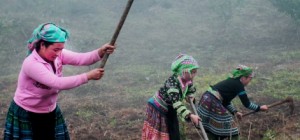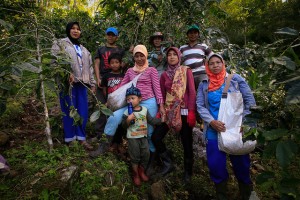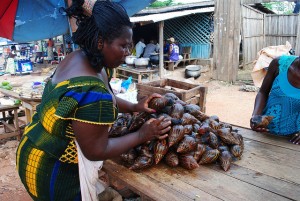ICRAF: Gender implications of agroforestry options in northwest Vietnam
CIAT: Partnership to expand LINK methodology to NTFP value chains in Nicaragua and Honduras

World Agroforestry Centre (ICRAF)
Gender implications of agroforestry options in northwest Vietnam
Under this project, agroforestry (AF) systems have been established in three agro-ecological zones: above 800m altitude, between 600m and 800m, and below 600m. These agro-ecological zones are closely related to the distribution of ethnic groups living in these areas. Areas above 800m are normally populated by Hmong people; between 600m-800m by Thai people, partly by Kinh; and below 600m, by Kinh people.
The systems with Son Tra and Shan tea can potentially be adopted by Hmong farmers and the systems, while Longan, macadamia, coffee and complex systems can potentially be adopted by Thai and a small part of the Kinh people. The gender implications of AF options by context will therefore be assessed according to the ethnic groups present in each zone. The study seeks to generate information on changes in the responsibilities of men and women when they adopt any of the AF systems and whether the information provided by women groups are different from that provided by men groups.
For more information, contact Delia Catacutan – d.catacutan@cgiar.org
Enhancing the gender-responsiveness of value chain tools to improve smallholder livelihoods
FTA is collaborating with the Policies, Institutions and Markets (PIM) CRP to enhance the gender-responsiveness of the 5Capitals tool designed to analyze the poverty impacts of value chain development. 5Capitals is a methodology for assessing such impacts by identifying changes in assets at the level of both smallholder households and collective enterprises, linking them with downstream chain actors.
Using a simple traffic light system (green, yellow or red) for illustrating condensed data, the methodology shows whether given value chain interventions have positive, neutral or negative effects on smallholder household and business assets. The underlying assumption is that the greater a household’s access to livelihood assets—social, human, natural, financial and physical—the higher its well-being and resilience. Likewise, the greater a smallholder enterprise’s set of assets, the better its performance and economic viability.

Yet, even within a given household, there are often pronounced gender and inter-generational inequities in access to and control over assets that shape women’s and men’s participation in and benefits from value chain development. Asset management and decision-making opportunities are also gendered within enterprises. For example, membership in some producer cooperatives is reserved to (generally male) heads of households, particularly if they are the formal owners of household land.
Bioversity and ICRAF scientists are opening up the black box of the household to understand how gender-specific asset endowments can constrain or facilitate women’s and men’s engagement in value chains, and how value chain development in turn affects intra-household asset distribution and holdings. At the enterprise level, they are analyzing gender equity in governance structures and how this can influence enterprise inclusiveness and performance.
The revised tool will be validated in several field settings, from Guatemala to India, later this year and early next year.
This research is part of a larger multi-centre project that brings a gender lens to PIM value chain tools to improve equity and success among smallholders participating in value chains.

Partnership to expand LINK methodology to NTFP value chains in Nicaragua and Honduras
CIAT-FTA is partnering with the CIAT Linking Farmers to Markets group to identify strategies to integrate gender in CIAT’s LINK methodology, a participatory guide to business models that link smallholders to markets.
The new methodology will be implemented and evaluated this year in NTFP value chains in Nicaragua and Honduras. Partners include FAO and VECO Mesoamérica.











